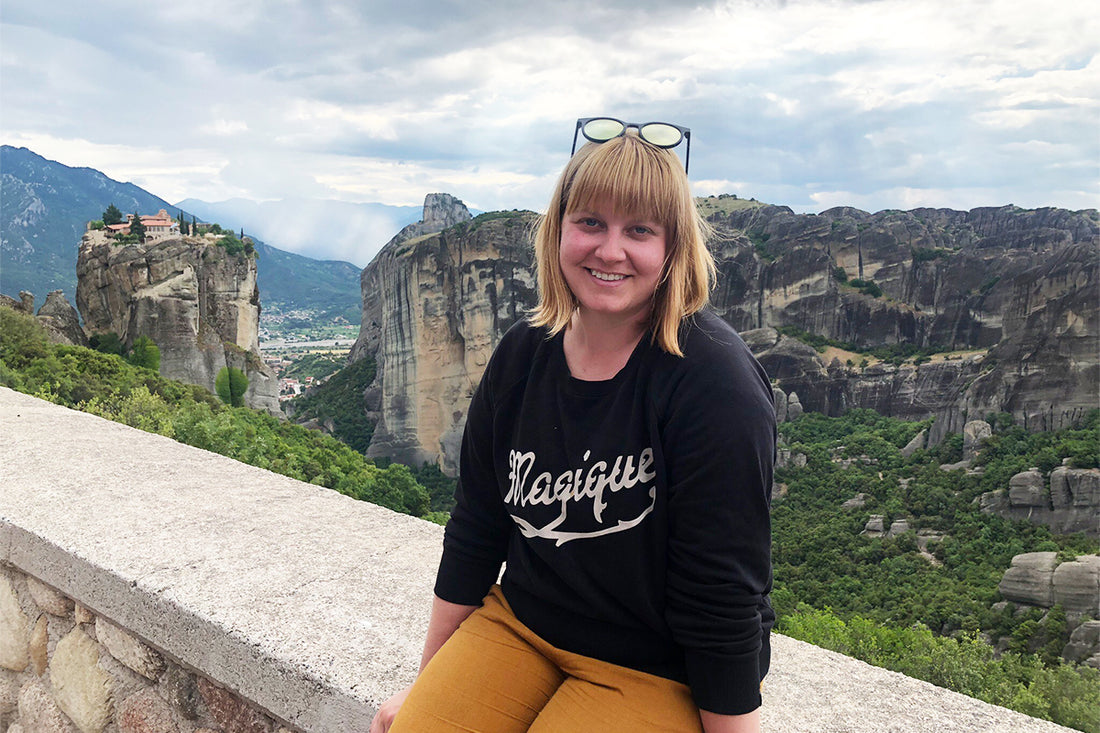Calgary plein air and travel sketcher Jesse Horne @jsshrn discusses deciding to make art a priority, her most memorable interactions with onlookers while travel sketching, and advice for aspiring outdoor artists in her interview for the latest Pentalic blog.
By Pentalic
When did you know that you wanted to be an artist?
I’ve always wanted to be an artist. From as early as I can remember, I was drawing, painting and illustrating my own stories. As I got older, I sort of thought that I had to get a “real” job, so I dabbled in a few different things while attending university. I worked a lot of mediocre customer service jobs and realized that I really didn’t want to do anything but art, so, about four years ago, I made that my priority.
What initially attracted you to plein air painting?
It’s truly a way to be in the moment, and really pay attention to what’s around you. Especially when you sit down to paint something you’ve seen a hundred times before; there’s so much more to be discovered while painting a familiar scene. It sounds cheesy, but sometimes painting feels like meditation to me.

I also find plein air painting to be incredibly challenging, as it is very different from using photographic references. You have to make so many quick decisions on how to depict the light as it changes, what to simplify and what to highlight. I have been doing plein air painting for about two years now and I am still challenged and baffled every time I go out with my kit.
We recently saw the flip-throughs of the Aqua Journals you filled up with plein air/ travel sketch paintings made during your trip to Greece. What draws you to travel sketching over solely taking photographs of your vacations?
I love painting when I travel for all the reasons I just mentioned above, but I especially love who I end up talking to when I go to other places. You sort of get lost behind a camera lens, especially in a tourist location; it’s not that interesting to see someone taking a photo. A camera can make you more distant from a place, but I find that with a sketchbook, you make these little connections, and it varies from country to country what people’s reactions will be.

When I sit down to paint, I’m committing time and effort to get to know a scene or place. More often than not, I get approached by curious onlookers who want to see what I’m up to. While traveling in India, I was nearly mobbed whenever I would sketch; people were so excited and curious that they’d ask for photos and want to hold my book. In Belgium, I had a man give me a very tough critique while I worked on a painting. In Peru, I ended up helping a group of women with their English classes. I would never have gotten any of these interactions if I were holding a camera.
I also have very close sensory ties to the images I create when I’m traveling; I can almost always remember where I was sitting, what the weather was like, who I spoke to. Painting creates a much clearer memory for me than a snapshot does.
You have painted on location in many pretty places found in your hometown. Which places have been your favorite spots around Calgary to paint so far?
Calgary is a really green city. We have a lot of parks that I frequent, especially Nose Hill and Confederation Park. I love painting by the river. It can look so different, depending on the time of day and the season. There’s a good mix of pure nature and city near the river. Calgary can be pretty tough to paint in outside of May through September, as we get a lot of snow, but I’ve been working on getting out even if it’s not ideal weather. In the winter I like to paint in the park near my house on a sunny day, catching the blue shadows in the snow.

Favorite Pentalic product and why?
Definitely the Aqua Journal. I love that the paper is so thick and hardy that it rarely buckles; I can easily do an in-depth painting on both sides of a page and it will dry flat. I usually use the largest size, but I like that there are multiple sizes, which make them great to travel with. Lately, I’ve been bringing a small one and a large one when I travel. The small one fits in my purse, and the larger one fits in my backpack. So, on days that I don’t want to carry a backpack, I don’t have any excuse not to paint. The little elastic paintbrush holder is also a favorite feature of mine; I use it to hold a pencil, so I never forget one when I’m out and about.
Your painting style is so dynamic in color and lighting. It’s rich in detail, yet so silky. Do you have any artists that have inspired your artistic style?
I am a big fan of James Gurney (@jamesgurneyart)* and his plein air works. I’m still baffled by what he can do with just a few colors and a sketchbook. I also love the Studio Ghibli background artists and how they can create such great atmosphere and depth within their scenes.
*View our Artist Interview with James Gurney here!
You tell us that you have a penchant for painting animal artifacts, natural history specimens, landscapes or cityscapes. What is your favorite subject to paint and why?
I love to paint birds. They’re sort of infinitely complex; you can paint a bird very simply and it will be recognizable, but if you look closely at each feather and detail, it’s really easy to get lost. There’s an almost limitless variety in their species. There is a very strong history of artists and naturalists of the past who were fascinated with birds, which can be inspiring to look back at as an artist. I would have to say that my ultimate favorite subject, however, is whatever I paint while I am traveling; nothing it can beat being on the road with a sketchbook.

What has been a challenge you have faced in your artistic journey so far and how have you overcome it?
I think, going back to the first question, my biggest struggle so far has been to “decide” to be an artist. I spent so long trying other things, and worrying how I would make a living, that I put art to the side and thought I would just keep it quiet as a hobby or passion project. I put “decide” in quotes because I know now that there’s not really anything else I think I would be satisfied doing long term, so the decision was sort of already made for me. I wouldn’t say that I’ve overcome this challenge by any means, but, by making art a priority in my life, I’ve created a lot of opportunities and personal connections that have re-enforced the feeling that being an artist is the right decision for me.

Do you have any advice for artists wanting to step outside their studios and start painting en plein air?
It’s cliché, but just go out and do it! Try and be okay with the thought that your stuff probably won’t immediately be good, or even as you get better that there will be a lot of stuff you make that you still think isn’t good. It’s very simple to put together an easy and cheap painting or drawing kit. I see a lot of people with these really intense plein air set ups that they’ve custom made or bought, but I still go out with just a small backpack, and, usually, I sit on the ground or a bench-like surface, if I can find one. All you need to start is desire and a sketchbook. Find what you like about painting, and build your supplies from there.
Follow Jesse!
Instagram: @jsshrn


